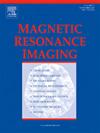A human-compatible gradient coil for visualizing ultrasound propagation
IF 2
4区 医学
Q2 RADIOLOGY, NUCLEAR MEDICINE & MEDICAL IMAGING
引用次数: 0
Abstract
In pursuit of a magnetic resonance imaging (MRI) based means to tailor transcranial focused ultrasound neuromodulation to a patient's unique skull morphology, this study presents a specialized gradient coil that sensitizes MRI images to ultrasonic vibrations at depths equivalent to the human cortex in a technique called the magnetic resonance hydrophone. The coil comprises a 60 mm diameter, pancake-style design that encodes acoustic displacements into MR images at the cost of an inhomogeneous encoding field. The coil was coupled with a 500 kHz, custom built, ultrasonic transducer. Both the magnetic field gradient of the coil and the acoustic field of the transducer were characterized in benchtop experiments. Acoustic standing waves were estimated in silico. Resulting MR images displayed a sinusoidal phase pattern modulated by both the transducer's acoustic field and the coil's magnetic field gradient. Acoustic pressures were estimated from the resulting images and compared to hydrophone measurements. The pancake-style coil produced a pressure measurement uncertainty pattern due to electronic noise that increased exponentially with depth. Uncertainty at locations between 0 and 30 mm of depth within a region approximately 10 mm wide scaled between approximately 20 kPa and 100 kPa. On average, the MRH underestimated the hydrophone by 12 kPa with the difference between the two following a standard deviation of 21 kPa.
用于超声传播可视化的人体兼容梯度线圈。
为了追求基于磁共振成像(MRI)的方法,根据患者独特的头骨形态定制经颅聚焦超声神经调节,本研究提出了一种专门的梯度线圈,该线圈在一种称为磁共振水听器的技术中,使MRI图像对相当于人类皮层深度的超声振动敏感。该线圈包括一个直径为60 mm的煎饼式设计,以非均匀编码场为代价将声学位移编码到MR图像中。线圈与500 kHz,定制的超声波换能器耦合。在台式实验中对线圈的磁场梯度和换能器的声场进行了表征。用计算机估计了声驻波。由此产生的磁共振图像显示出由换能器的声场和线圈的磁场梯度调制的正弦相位模式。根据所得图像估计声压,并与水听器测量结果进行比较。由于电子噪声随深度呈指数增长,煎饼式线圈产生了压力测量不确定度模式。在大约10 毫米宽的区域内,深度在0到30 毫米之间的不确定度在大约20 kPa到100 kPa之间。平均而言,MRH低估了水听器12 kPa,两者之间的差值为21 kPa。
本文章由计算机程序翻译,如有差异,请以英文原文为准。
求助全文
约1分钟内获得全文
求助全文
来源期刊

Magnetic resonance imaging
医学-核医学
CiteScore
4.70
自引率
4.00%
发文量
194
审稿时长
83 days
期刊介绍:
Magnetic Resonance Imaging (MRI) is the first international multidisciplinary journal encompassing physical, life, and clinical science investigations as they relate to the development and use of magnetic resonance imaging. MRI is dedicated to both basic research, technological innovation and applications, providing a single forum for communication among radiologists, physicists, chemists, biochemists, biologists, engineers, internists, pathologists, physiologists, computer scientists, and mathematicians.
 求助内容:
求助内容: 应助结果提醒方式:
应助结果提醒方式:


